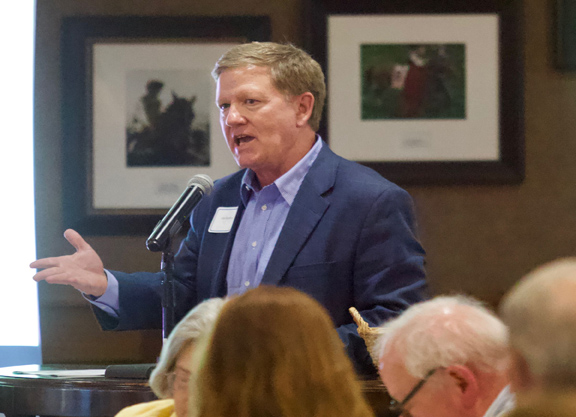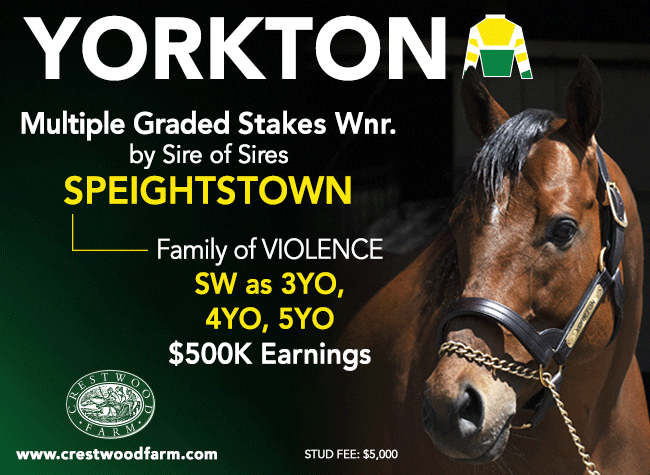By Lucas Marquardt
Think the local industry can easily shrug off the loss of California racing? Think again. That was one of the key takeaways during Tuesday evening's June membership meeting of the Kentucky Thoroughbred Farm Managers' Club. The KTFMC invited executives from the National Thoroughbred Racing Association to review of the response to the current crisis in California and to explain the NTRA's role addressing this and similar issues. The five-strong panel also included Dr. Steve Vickner, an economist and faculty member of the University of Louisville's Equine Industry Program.
It was Vickner who noted California's impact on the equine industry. In total, the U.S. equine industry generates $122 billion in economic activity each year. Of that, $8.3 billion originates in California. Kentucky, by contrast, generates $2.7 billion. Those figures include all equine activity and isn't limited to the Thoroughbred industry. But Thoroughbreds are a big slice of the pie. Later, it was pointed out that California tracks generate $3.1 billion in handle, or about 28% of the 2018 total U.S. handle of $11.2 billion.
Vickner stressed the interdependency between California and Kentucky racing. He estimated that Fasig-Tipton and Keeneland sold $56 million worth of horses to California interests in 2018. Another $2 million was generated for Kentucky in direct economic impact in food, travel and lodging.
“And that $58 million is like a rock thrown into a pond, and the ripple [generates] indirect effects,” said Vickner. The total impact? Between $87 and $116 million. “So if California buyers didn't buy [those horses], the way we'd feel it here in Kentucky would be the $87 to $116 million—not the $58 million. You have to consider the upstream impact on supply chains and the spending effects on the individuals who make their living in this industry.”
How likely is the death of California racing? Even just a few months ago, a permanent cessation might have seemed absurd. But 30 equine deaths at Santa Anita this winter and spring, and the national outrage that ensued, has changed the landscape. That was hammered home time and again Tuesday night.
NTRA COO Keith Chamblin pointed to the fates of SeaWorld's orca shows and the Ringling Bros. circus as potential harbingers. Just last year, Florida banned dog racing via ballot initiative. Chamblin said he recently conducted an informal test. He googled “SeaWorld Orca Whales” and “Circus Animal Abuse 2016” and got a combined 43,900 news links and 111,600 video links. He then googled “Santa Anita Horse Deaths 2019,” and got 93,300 news links and 110,000 video links.
“That's 30% more,” Chamblin said. “It gives you a sense of what we're dealing with. What role is the NTRA playing during the crisis, and what are we trying to tell our fellow members to do? In a word: act. We can't talk our way out of this crisis.”
Chamblin did say the NTRA is currently working on a Crisis Management Tool Kit for the industry. This will eventually include media training, a website resource center, a social media plan, fact sheets/white paper, outbound messaging, spokespeople and a post-crisis review process.
“Portions are in the works and the rest is more in the formative stages,” Chamblin said afterward. “This is a NTRA Board priority, but it will take time and continually evolve.”
The night largely focused on what's already been done to promote equine safety. Steve Koch, executive director of the NTRA's Safety & Integrity Alliance, spoke about measures taken to improve equine and human safety in the wake of the Eight Belles and Barbaro breakdowns over a decade ago. They include formation of the Alliance itself, as well as the launch of the Racing Surfaces Testing Laboratory, the Thoroughbred Aftercare Alliance and the Equine Injury Database. He also noted the continued work of the Racing Testing and Medication Consortium.
Koch said he expects some of the changes California has made this year to eventually become industry standards elsewhere. California is now holding workouts to the same regulatory standards as races, including pre-work examination by a regulatory veterinarian, medication and substance enforcement and risk profiling.
“There are a number of things in play that look simple on a slide, but are pretty significant new territory if you've spent much time at the racetrack,” said Koch.
NTRA CEO Alex Waldrop was on-hand and introduced the panel.
“If it was not clear before, it should be clear to all of us in racing that horse fatalities are the number-one threat to our industry,” he said. “We can let nothing deter us from searching out and eradicating every potential risk. It's not simply a public-relations challenge. It's a challenge to do everything we can to prevent horse injuries and fatalities in both the mornings and afternoon. We've done a lot, but we must do more. Only action will silence our critics.”
Waldrop fielded questions from the audience, and many of his answers ended with an admission of the NTRA's limitations. The idea of a central governing authority was raised several times. That would require states to relinquish power, he explained.
“And I can't stress enough how difficult it is to convince states to give up their autonomy,” Waldrop said. “I wish it weren't the case.”
The NTRA's role in shaping and delivering messages in times of crisis was also raised. When asked, Waldrop said the company has hired several crisis-management firms. “But to be fair, the firestorm that we've faced has overwhelmed even the best efforts,” he said. “When you look at the volume of material—most of which is on television—that is a new thing for our industry. We have entities that have one point of content, and they push it out over hundreds of their media outlets. It's a whole new landscape. And then you have social media, which is as decentralized as it gets. It's a huge challenge. We're just beginning to understand what we're facing.”
Waldrop offered an anecdote about the difficulty in shaping the narrative. “We are being proactive,” he said. “The challenge is that the editors make the decision on what ends up on the cutting-room floor. And frankly, bad stories sell. The day after the [Kentucky] Derby DQ, we finally got on the CBS Evening News. We spent about 45 minutes during our shoot talking about the problems facing racing. [In the broadcast] I wound up getting three seconds: my response to a tweet from Donald Trump.”
The KTFMC event, which attracted an estimated 175 people, was held in the Seattle Slew room at Fasig-Tipton.
Not a subscriber? Click here to sign up for the daily PDF or alerts.






